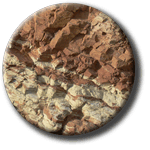egionally Important Geological and Geomorphological Sites (RIGS),
identified by locally developed criteria, are currently the most important places
for geology and  geomorphology
outside statutorily protected land such as Sites
of Special Scientific Interest
geomorphology
outside statutorily protected land such as Sites
of Special Scientific Interest  (SSSI) which include sites of earth science importance as well as biological
ones.
(SSSI) which include sites of earth science importance as well as biological
ones.
RIGS are selected in a different way to Earth science SSSIs,
which are chosen on a national basis. RIGS are selected on a local or regional
basis using four nationally agreed criteria:
• The value of the site for educational purposes
in life long learning.
• The value of the site for study by both professional and amateur Earth
scientists.
• The historical value of the site in terms of important advances in
Earth science knowledge, events or human exploitation.
• The aesthetic value of a site in the landscape, particularly in relation
to promoting public awareness and appreciation of Earth sciences.
Local RIGS groups, of which there are 30 in England and Wales
(2004), often devise additional criteria based on these national parameters
depending on local or regional circumstances. The concept of RIGS was first
initiated by the Nature Conservancy Councils (NCC) publication Earth Science
Conservation in Great Britain – A Strategy (1990).
RIGS sites started life as SSSIs denotified after the Geological
Conservation Review (1997-1990). The statutory agencies wished to secure their
conservation in another form. RIGS sites are those which, whilst not benefiting
from national statutory protection, are nevertheless regionally or locally representative
sites where ".... consideration of their importance becomes integral to
the planning process" according to the Earth Science Conservation Strategy
(ESCS).
RIGS were introduced in 1990 and are analogous to SINCs and other non-statutory wildlife designations. They can be listed in local authorities'
development plans and shown on "alert maps". RIGS can be protected
through the planning system if a RIGS group recommends sites to the local planning
authority. Conservation and management of sites will usually depend upon agreements
and co-operation with landowners.
and other non-statutory wildlife designations. They can be listed in local authorities'
development plans and shown on "alert maps". RIGS can be protected
through the planning system if a RIGS group recommends sites to the local planning
authority. Conservation and management of sites will usually depend upon agreements
and co-operation with landowners.
UKRIGS group:
a good page to find out more about RIGS and contacts, and from which much of
the above has been taken.
Gloucestershire Geology Trust
Hereford and Worcester Earth Heritage
Trust

 geomorphology
outside statutorily protected land such as
geomorphology
outside statutorily protected land such as